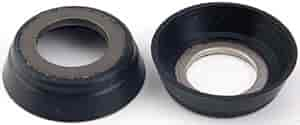Although the stock dog bones I have are fine, but obsolete, I was worried the Banski adjustable C4 trailing arms might end up not being available, and go out of production too, so I ordered a set at 20% clearance price. Near as I can tell they only have 4 sets left, since I just bought one. Got the $32 boots too. There is no fuckin way I would use poly on the trailing arms. With up to 3 degrees of rotation under load they will bind, and be unpredictable, and change over time as they wear in. Maybe when Porsche, and BMW use poly I will change my mind.
http://www.ebay.com/itm/C4-Corvette-...-/151834813454




 Reply With Quote
Reply With Quote
 . And once those heims wear (and they will) they're going to be clattering down the road. Ask people who use heims on suspension parts about the wear and noise.
. And once those heims wear (and they will) they're going to be clattering down the road. Ask people who use heims on suspension parts about the wear and noise.  If it does, you should panic about that.
If it does, you should panic about that.

 and power. I think you're going to hate the heims on the street....most guys do because of the vibration and noise.
and power. I think you're going to hate the heims on the street....most guys do because of the vibration and noise.
